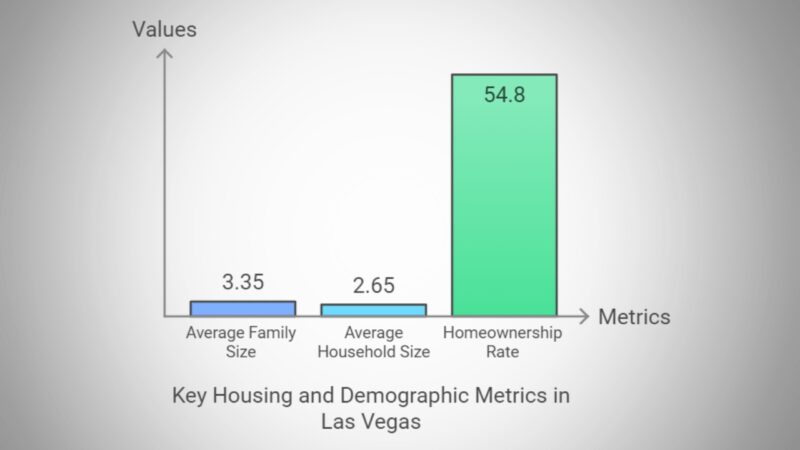Las Vegas has been the 7th fastest-growing metro in the country for over the past three years. The city offers good jobs, an entertaining lifestyle, and a booming housing market, attracting more people and businesses. The Las Vegas population in 2025 is nearly 3 million.
Did you know that Las Vegas has grown from a modest population of 34,828 in 1950 to an estimated metro area of 2,952,756 in 2025?
But in the city only lives around 665,640 people.
In just the last year alone, the city added 53,369 new residents, marking a 1.84% annual growth rate.
That’s a remarkable transformation for a city that started as a small desert town.
Table of ContentsKey Takeaways
8. Population is On Rise

Aerial View of Las Vegas, Nevada, Showing a Sprawling Residential Area with The City’s Famous Skyline in The Background
Las Vegas, located in Clark County, Nevada, is home to 665,640 residents as of 2025 and serves as the county seat. The city is growing at an annual rate of 0.71%, with its population increasing by 2.91% since the 2020 census, which recorded 646,794 people.
On average, households in Las Vegas earn $93,515, but 14.67% of the population lives below the poverty line. The median age in the city is 38.1 years, with men having a median age of 37.2 and women at 38.8 years.
As Nevada’s most populous city, Las Vegas is world-famous for its casinos, shopping, dining, and vibrant nightlife. While it’s known as the Entertainment Capital of the World, it’s also becoming increasingly popular as a family-friendly and retirement destination.
The broader Las Vegas metropolitan area boasts a population of over 2 million people. When people mention Las Vegas, they’re often referring not just to the city itself, but also to the surrounding areas, especially the famous Las Vegas Strip.
Interestingly, the 4.2-mile-long Strip, known for its iconic resorts and casinos, is actually located in the unincorporated areas of Enterprise, Winchester, and Paradise, not within Las Vegas city limits.
With a population density of 4,376 people per square mile, Las Vegas continues to be a dynamic and rapidly evolving city.
Did you know that of all live births in Las Vegas during 2020-2022 (average), 41.0% were Hispanic, 25.7% were White, 17.4% were Black, 0.3% were American Indian/Alaska Native and 9.9% were Asian/Pacific Islander.
7. Progress Despite Recession
It is interesting that the fertility rate for the US in 2024 is 0.11% higher than in 2023.
Before the recession, Clark County was expected to surpass a population of 2 million in 2006, but that milestone still hasn’t been reached. However, the county, which includes Las Vegas, is projected to grow to 2.5 million people by 2031.
Las Vegas itself is making a steady recovery from the recession. Forbes now ranks it as the 11th fastest-growing metro area, showing that the city is finally overcoming the stagnation it faced during the downturn.
Despite this progress, the region continues to struggle with one of the highest foreclosure rates and largest inventories of vacant homes in the country. But even with those challenges, Las Vegas is attracting new residents and businesses.
The Las Vegas-Paradise metro area is expected to grow from 1.988 million people in 2012 to 3.32 million by 2042, marking a massive 67% increase—one of the largest population booms in the U.S.

The Image Shows a Panoramic Night View of The Las Vegas Strip
The history of Las Vegas goes back to 1829 when European explorer Raphael Rivera was the first to visit the valley. The name “Las Vegas” was given by Spaniards in the Antonio Armijo party, who found water in the area while traveling the Old Spanish Trail.
In 1844, when the region was still part of Mexico, a group from the U.S. Army Corps of Engineers arrived in the Las Vegas Valley. After the U.S. annexed the area, Brigham Young sent LDS missionaries in 1855 to convert the local Paiute Indians.
The Mormons built a fort in what is now downtown Las Vegas, serving as a key stop on the “Mormon Corridor” between San Bernardino, California, and Salt Lake City. However, the Mormons left Las Vegas in 1857 during the Utah War, and it became a railroad hub in the following years.
By the early 1900s, Las Vegas was a bustling railroad town and a key stop for nearby mines. While its importance diminished as railroads expanded, the construction of the Hoover Dam in 1935 sparked growth in both population and tourism.
Modern Las Vegas truly began with the legalization of gambling in 1931. The development of casino hotels took off, initially fueled by scientists and staff working on the Manhattan Project. Soon after, organized crime figures stepped in to finance and manage many of the early casinos.
Today, Las Vegas is famous for its vibrant adult entertainment scene, earning it the nickname “Sin City,” and it’s one of the most popular tourist destinations in the world.
6. Challenges with Infrastructure and Resources (Traffic, Healthcare)

Aerial View of Las Vegas Showing the City Skyline with Surrounding Desert and Mountains
All this growth isn’t without its problems. The more people we have, the more strain it puts on our roads, water supply, and public services. Traffic is getting worse, and we need to invest big in public transit and road improvements to handle it.
Fun fact: The famous Las Vegas Strip is actually not in Las Vegas but in the neighboring town of Paradise, and this area alone sees tens of thousands of cars every day.
Water is another huge issue. Las Vegas relies on the Colorado River, and with so many new residents, we’ve got to get serious about water conservation. Even with efforts to use less, making sure we have enough water for the future is a major challenge.
Healthcare, schools, and other public services also need to expand to support our growing population. We’ve got to make sure everyone has access to the quality services they need.
The city is already planning for new schools and healthcare facilities to accommodate the increasing number of residents, ensuring that quality of life remains high and that the biggest killer in the U.S., cardiovascular diseases stays in control.
5. Urban Heat Island Effect
As Las Vegas gets more crowded, we’re also dealing with the “urban heat island” effect. That means the city is WAY hotter than the areas around it. This is caused by all the buildings, roads, and human activity trapping heat. Las Vegas has the highest average summer temperatures of any major city in the United States, often soaring above 100°F.
The extra heat can make people sick and put a big strain on our power grid as we all crank up the air conditioning. To fight this, the city is working on green spaces, parks, and other ways to cool things down. It’s an important issue for the health and comfort of residents like me.
The city’s plans include adding over 1,000 acres of new parks and green areas by 2030, aiming to cool the city and provide more recreational spaces.
4. Saving Water
The Southern Nevada Water Authority is extending one of its programs, helping homeowners and water conservation. https://t.co/40IfBJdMrP
— KSNV News 3 Las Vegas (@News3LV) September 19, 2024
Saving water is a top priority for Las Vegas. The city is really pushing water-efficient landscaping, recycling technology, and programs to help people use less.
The Southern Nevada Water Authority is leading these efforts to secure our water supply for the future. Las Vegas recycles nearly 100% of its indoor water, a remarkable feat that sets a standard for water conservation in arid regions.
But with the drought in the West and our growing population, water is still a huge concern. We’ve got to keep innovating and investing in smart water management to make sure there’s enough for everyone.
Fun fact: The iconic Bellagio Fountains are actually part of a sophisticated water conservation system that helps manage the city’s water resources effectively.
3. Housing Is Becoming More Sustainable

Aerial View of Las Vegas Showcasing Residential Areas and The Distant Strip Against a Backdrop of Mountains
As Las Vegas expands, the city is getting creative with housing and development. Instead of just sprawling outward, they’re focusing on higher-density, mixed-use projects.
These combine homes, shops, and recreation in one area, so people don’t have to drive everywhere. For instance, the Downtown Las Vegas area has been revitalized with a focus on mixed-use developments that blend residential and commercial spaces.
They’re also looking at filling in empty or underused spaces within the city, rather than just building out. This “infill” approach helps us grow without taking up too much new land and overwhelming our infrastructure. The city is also promoting the development of “walkable” communities, which are designed to reduce reliance on cars and enhance quality of life.
These strategies are all part of making Las Vegas more sustainable and livable as we continue to grow. By being smart about how we develop, the city can keep expanding while preserving the quality of life for residents like me.
Household Type
Total Households
Average Household Size
% Owner-Occupied
% Renter-Occupied
All Households
240,462
2.65
54.8%
45.2%
Married
99,589
3.4
70%
30%
Non-Family
90,654
1.29
44.1%
55.9%
Female-Headed
34,313
3.64
41.2%
58.8%
Male-Headed
15,906
3.6
50.2%
49.8%
Key Statistics

2. Economy and Education Is On Rise
The economy of Las Vegas is changing too. We’re not just about tourism and entertainment anymore. We’re seeing big growth in tech, healthcare, and logistics – creating lots of new job opportunities for a diverse workforce.
Fun fact: Las Vegas is home to the largest tech conference in the world, CES, which draws over 170,000 attendees annually, showcasing the city’s growing role in the tech industry.
Economic Factors
- Employment: As of mid-2024, total employment in the Las Vegas metro area has grown, with the region experiencing a 5% growth rate compared to the previous year, surpassing national employment growth averages. Total employment now stands at over 1.06 million jobs according to Las Vegas Global Economic Alliance.
- Unemployment: The unemployment rate is currently around 5.3%, a significant improvement from the pandemic peak but still higher than the national average of 3.5%.
- Industries: Key industries driving growth include tourism, hospitality, and gaming, which continue to recover with over 50 million passengers passing through Harry Reid International Airport in 2024. The city is also diversifying into technology and healthcare as per Vegas PBS.
- Housing: The housing market has shown signs of cooling, with the median price for single-family homes sitting around $440,000, reflecting a 7.3% increase from 2023).
Educational Factors
- Higher Education: The University of Nevada, Las Vegas (UNLV), continues to play a significant role in the city’s educational development. In 2024, UNLV is involved in various innovation initiatives, including tourism and robotics, contributing to economic diversification. The university’s No. 1-ranked Harrah College of Hospitality remains a strong asset for the city.
-
Workforce Development: Las Vegas has invested heavily in workforce education and training programs. Partnerships between local businesses and educational institutions aim to equip the workforce with skills necessary for industries like healthcare and advanced manufacturing.
1. Good Public Safety

An Artistic Metallic Sculpture with Ribbon-Like Elements Stands in Front of High-Rise Buildings in Las Vegas
The city actively involves the community in planning and development decisions. We get to share our priorities, like improving public safety, education, and healthcare.
Las Vegas is known for its extensive public outreach efforts, including community workshops and surveys to gather input from residents.
This feedback helps the city create a master plan that works for everyone. By working together, residents and officials can make sure Las Vegas expands in a way that enhances life for all of us who call this place home.
The city’s comprehensive planning process includes a vision for a more sustainable, inclusive, and prosperous Las Vegas for future generations.
Henderson: Comparing Populations with Las Vegas
Henderson went from a small town in the 1940s to Nevada’s second-largest city by taking advantage of its proximity to Las Vegas and attracting a diverse population.
Henderson is a city in Nevada, just 16 miles southeast of Las Vegas. It has a population of around 340,000 people. Las Vegas, the largest city in Nevada, has about 660,000 residents. So, Henderson’s population is roughly half of Las Vegas’s, but it’s still the second-largest city in the state.
Rapid Growth
From 2010 to 2020, the population increased by 23%. That’s a bit quicker than Las Vegas, which grew by about 15% during the same time. This growth shows that Henderson is a popular place to live and work, and it’s becoming a bigger part of the Las Vegas area.
Demographic
The city is home to a vibrant community with people from various cultural backgrounds, making it a lively and inclusive place to live.
People in Henderson tend to be a bit older, with a median age of 42 years, compared to Las Vegas, where the median age is 37 years. This means there are more families and older adults living in Henderson.
Similar trends can be observed in nearby Utah, where family-oriented communities often attract a slightly older demographic.
Also, the average household income in Henderson is higher, at around $75,000, compared to $59,000 in Las Vegas. This suggests that many people living in Henderson are doing quite well financially.
Henderson has a birth rate of around 11 births per 1,000 people each year. This is slightly lower than the national average of 12 births per 1,000 people.
Conclusion
Population growth brings both opportunities and challenges. The steady population increase is fueled by jobs, housing, and lifestyle – but it also strains our infrastructure, water, and public services.
To manage this growth, Las Vegas is focusing on sustainable development, smart water use, and economic diversification.








